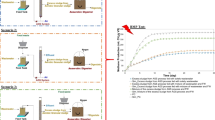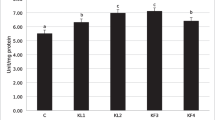Abstract
Olive flounder (OF) and Starry flounder (SF) are the commonly cultured fish species in the South Korea East Sea. Evaluation of whether those dead fish wastes are suitable for anaerobic digestion is required. The aim of this study was to characterize the physicochemical properties of each fraction which was flesh, bone, head, skin, viscera, and whole fish OF and SF and evaluate their biochemical methane potential (BMP). The results showed that both dead fish species’ wastes mainly contained proteins (48–75% of volatile solids [VS]) and lipids (19–40% of VS), whereas carbohydrates were little found (0.7–5% of VS). The BMP of each fraction was investigated in a mesophilic condition and the substrate-to-microbe ratio was 0.5 g CODsubstrate/g VSSinoculum. The results showed that the bone fractions in both OF and SF showed the highest methane yield with 0.37 and 0.38 L CH4/g CODadded, respectively whereas the viscera fractions of both fish species showed the lowest methane yield with 0.20 L CH4/g CODadded. The modified Gompertz model showed that the longest lag phase was observed in the bone fractions of OF and SF with 1.59 d and 2.62 d and the shortest lag phase was in the viscera fraction of OF and SF with 0.37 d and 0.58 d, respectively. The energy recovery of every fraction of both species ranged 43–69%. Principal component analysis indicated that the viscera fraction of OF and SF had different characteristics from the other fractions. This study suggests that dead fish wastes can be considered for biogas production.
Similar content being viewed by others
References
Venkiteshwaran, K., B. Bocher, J. Maki, and D. Zitomer (2015) Relating anaerobic digestion microbial community and process function: supplementary issue: water microbiology. Microbiol. Insights. 8s2: 37–44.
Kim, M.-S., D.-H. Kim, and Y.-M. Yun (2017) Effect of operation temperature on anaerobic digestion of food waste: performance and microbial analysis. Fuel (Lond.) 209: 598–605.
Park, Y. G. (2021) Study for the bio-CNG recovery of methane gas in the anaerobic co-digestion using Malaysian POME (palm oil mill effluent). Biotechnol. Bioprocess Eng. 26: 435–446.
Wang, W. and D.-J. Lee (2021) Valorization of anaerobic digestion digestate: a prospect review. Bioresour. Technol. 323: 124626.
Kim, S.-S. and J.-D. Kim (2019) Overview on the development of aquaculture and aquafeed production in Korea. Aquac. Indones. 20: 1–7.
Korean Statistical Information Service. http://kosis.kr/statHtml/statHtml.do?orgId=101&tblId=DT_1EW0005&conn_path=I3.
Jee, B. Y., K. W. Shin, D. W. Lee, Y. J. Kim, and M. K. Lee (2014) Monitoring of the mortalities and medications in the inland farms of olive flounder, Paralichthys olivaceus, in South Korea. J. Fish Pathol. 27: 77–83.
Dai, X., S. Chen, Y. Xue, L. Dai, N. Li, J. Takahashi, and W. Zhao (2015) Hygienic treatment and energy recovery of dead animals by high solid co-digestion with vinasse under mesophilic condition: feasibility study. J. Hazard. Mater. 297: 320–328.
Yulisa, A., J. Lee, S. H. Park, and S. Hwang (2022) Simultaneous effect of cathode potentials and magnetite concentrations on methanogenesis of acetic acid under different ammonia conditions. Environ. Eng. Res. 27: 210317.
Ma, J., Q.-B. Zhao, L. L. M. Laurens, E. E. Jarvis, N. J. Nagle, S. Chen, and C. S. Frear (2015) Mechanism, kinetics and microbiology of inhibition caused by long-chain fatty acids in anaerobic digestion of algal biomass. Biotechnol. Biofuels. 8: 141.
Lim, S. J. and P. Fox (2013) Biochemical methane potential (BMP) test for thickened sludge using anaerobic granular sludge at different inoculum/substrate ratios. Biotechnol. Bioprocess Eng. 18: 306–312.
Eiroa, M., J. C. Costa, M. M. Alves, C. Kennes, and M. C. Veiga (2012) Evaluation of the biomethane potential of solid fish waste. Waste Manag. 32: 1347–1352.
Bücker, F., M. Marder, M. R. Peiter, D. N. Lehn, V. M. Esquerdo, L. Antonio de Almeida Pinto, and O. Konrad (2020) Fish waste: an efficient alternative to biogas and methane production in an anaerobic mono-digestion system. Renew. Energy. 147: 798–805.
Kafle, G. K. and S. H. Kim (2012) Evaluation of the biogas productivity potential of fish waste: a lab scale batch study. J. Biosyst. Eng. 37: 302–313.
Angelidaki, I. and W. Sanders (2004) Assessment of the anaerobic biodegradability of macropollutants. Rev. Environ. Sci. Biotechnol. 3: 117–129.
Ghaly, A. E., V. V. Ramakrishnan, M. S. Brooks, S. M. Budge, and D. Dave (2013) Fish processing wastes as a potential source of proteins, amino acids and oils: a critical review. J. Microb. Biochem. Technol. 5: 107–129.
Zhang, Y. and H. Li (2019) Energy recovery from wastewater treatment plants through sludge anaerobic digestion: effect of low-organic-content sludge. Environ. Sci. Pollut. Res. Int. 26: 30544–30553.
Abu Hanifa Jannat, M., S. Hyeok Park, C. Chairattanawat, A. Yulisa, and S. Hwang (2022) Effect of different microbial seeds on batch anaerobic digestion of fish waste. Bioresour. Technol. 349: 126834.
Álvarez, J. A., L. Otero, and J. M. Lema (2010) A methodology for optimising feed composition for anaerobic co-digestion of agro-industrial wastes. Bioresour. Technol. 101: 1153–1158.
Xue, S., Y. Wang, X. Lyu, N. Zhao, J. Song, X. Wang, and G. Yang (2020) Interactive effects of carbohydrate, lipid, protein composition and carbon/nitrogen ratio on biogas production of different food wastes. Bioresour. Technol. 312: 123566.
Montes, J. A., R. Leivas, D. Martínez-Prieto, and C. Rico (2019) Biogas production from the liquid waste of distilled gin production: optimization of UASB reactor performance with increasing organic loading rate for co-digestion with swine wastewater. Bioresour. Technol. 274: 43–47.
Bouallagui, H., H. Lahdheb, E. Ben Romdan, B. Rachdi, and M. Hamdi (2009) Improvement of fruit and vegetable waste anaerobic digestion performance and stability with co-substrates addition. J. Environ. Manage. 90: 1844–1849.
Wu, Y. and K. Song (2021) Anaerobic co-digestion of waste activated sludge and fish waste: methane production performance and mechanism analysis. J. Clean. Prod. 279: 123678.
Palani kumar, M., A. Ruba Annathai, R. Jeya Shakila, and S. A. Shanmugam (2014) Proximate and major mineral composition of 23 medium sized marine fin fishes landed in the Thoothukudi Coast of India. J. Nutr. Food Sci. 4: 1000259.
Chen, Y., J. J. Cheng, and K. S. Creamer (2008) Inhibition of anaerobic digestion process: a review. Bioresour. Technol. 99: 4044–4064.
Zhao, J., Y. Li, S. Pan, Q. Tu, W. Dang, Z. Wang, and H. Zhu (2018) Effects of magnesium chloride on the anaerobic digestion and the implication on forward osmosis membrane bioreactor for sludge anaerobic digestion. Bioresour. Technol. 268: 700–707.
Zhang, H., Y. He, T. Jiang, and F. Yang (2011) Research on characteristics of aerobic granules treating petrochemical wastewater by acclimation and co-metabolism methods. Desalination. 279: 69–74.
Donoso-Bravo, A., F. Bindels, P. A. Gerin, and A. Vande Wouwer (2015) Anaerobic biodegradability of fish remains: experimental investigation and parameter estimation. Water Sci. Technol. 71: 922–928.
Fernandez-Torres, R., M. A. B. Lopez, M. O. Consentino, M. C. Mochon, and M. R. Payan (2011) Enzymatic-microwave assisted extraction and high-performance liquid chromatography-mass spectrometry for the determination of selected veterinary antibiotics in fish and mussel samples. J. Pharm. Biomed. Anal. 54: 1146–1156.
Xiao, L., Y. Wang, E. Lichtfouse, Z. Li, P. S. Kumar, J. Liu, D. Feng, Q. Yang, and F. Liu (2021) Effect of antibiotics on the microbial efficiency of anaerobic digestion of wastewater: a review. Front. Microbiol. 11: 611613.
Saha, S., M. B. Kurade, G.-S. Ha, S. S. Lee, H.-S. Roh, Y.-K. Park, and B.-H. Jeon (2021) Syntrophic metabolism facilitates Methanosarcina-led methanation in the anaerobic digestion of lipidic slaughterhouse waste. Bioresour. Technol. 335: 125250.
Yan, B. H., A. Selvam, and J. W. C. Wong (2020) Bio-hydrogen and methane production from two-phase anaerobic digestion of food waste under the scheme of acidogenic off-gas reuse. Bioresour. Technol. 297: 122400.
Gruduls, A., K. Balina, K. Ivanovs, and F. Romagnoli (2018) Low temperature BMP tests using fish waste from invasive Round goby of the Baltic Sea. Agron. Res. 16: 398–409.
Malik, R. N., M. Z. Hashmi, and Y. Huma (2014) Heavy metal accumulation in edible fish species from Rawal Lake Reservoir, Pakistan. Environ. Sci. Pollut. Res. Int. 21: 1188–1196.
Garcia, N. H., A. Mattioli, A. Gil, N. Frison, F. Battista, and D. Bolzonella (2019) Evaluation of the methane potential of different agricultural and food processing substrates for improved biogas production in rural areas. Renew. Sustain. Energy Rev. 112: 1–10.
Neves, L., E. Gonçalo, R. Oliveira, and M. M. Alves (2008) Influence of composition on the biomethanation potential of restaurant waste at mesophilic temperatures. Waste Manag. 28: 965–972.
Acknowledgements
This work was financially supported by the Korea Institute of Energy Technology Evaluation and Planning, Republic of Korea (KETEP) and the Ministry of Trade, Industry & Energy (MOTIE) of the Republic of Korea (No. 201830 10092790). This research was financially supported by the Korea Ministry of Environment as Waste to Energy-Recycling Human Resource Development Project (No. YL-WE-21-002).
Author information
Authors and Affiliations
Corresponding author
Ethics declarations
The authors declare no conflict of interest.
Neither ethical approval nor informed consent was required for this study.
Additional information
Publisher’s Note Springer Nature remains neutral with regard to jurisdictional claims in published maps and institutional affiliations.
Electronic supplementary material
Rights and permissions
About this article
Cite this article
Chairattanawat, C., Yulisa, A., Park, S.H. et al. Physicochemical Characteristics and Biogas Production Potentials of Olive Flounder and Starry Flounder Wastes. Biotechnol Bioproc E 27, 678–686 (2022). https://doi.org/10.1007/s12257-022-0102-0
Received:
Revised:
Accepted:
Published:
Issue Date:
DOI: https://doi.org/10.1007/s12257-022-0102-0




